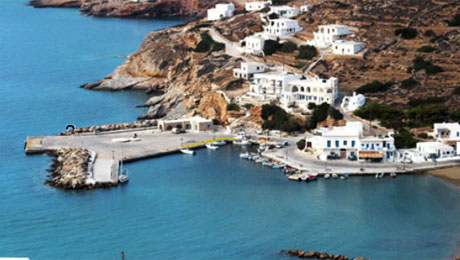Kastro, Ada Makri (http://www.photosikinos.com)
In the southern part of the Cycladic islands, between the islands Ios and Folegandros, is Sikinos island (http://bit.ly/Lyt6P5), one of the smallest Cycladic islands where the permanent residents are estimated at less than 300, and There are three residential ares: Alopronoia (small harbour on the island), Chorio and Kastro.
For many years Sikinos was an island off the major tourist track and thus it has managed to retain its authentic look, away from excessive touristic development. Today the island impresses with its natural beauty, tranquility, affordability and its friendly inhabitants who have preserved in a natural way the manners and customs of their ancestors.
The main road of the island is 8 km long and runs from Alopronoia reaching the Bishops. Another road, shortly before Castro, on the right, leads to the beach of Agios Georgios. One of the features of Sikinos are its 61 chapels. There are also six Byzantine churches with frescoes from the 13th and 14th century.
Alopronoia

Photo: http://www.sikinos.gr
Alopronoia is the small harbour on the island. You can go for a swim at the largest beach on the island, Livadi, and enjoy a delicious meal in the taverns of the village on the sea coast. There you will find hotels and rooms for rent, supermarkets, cafes and restaurants to enjoy the evening.
From Alopronoia there is a bus to the island's capital and for the Bishops, as well as the boat for excursions to some more remote beaches of Sikinos.
Chorio and Kastro
Chorio and Kastro are two beautiful villages that form the island's capital, with their stone, whitewashed houses and narrow picturesque streets, about 3.5 km away from the port.

Chorio and Kastro, photo Dimitrios Fukas (http://www.photosikinos.com)
To the north Kastro (translated the name means "fortress") was built on the edge of a precipice 280 metres above the sea. This is an old fortified settlement from the 15th century, where today beats the heart of the island. Here are the square, the city hall, the hospital, shops and most of the restaurants. Take a walk around its narrow streets and the surrounding area to see the ancient wealthy houses, the richly carved gold-plated iconostasis in the church "Pandanasa" as well as the ancient icons painted by hand by the great painters of the past, exhibited at the Byzantine Museum.
The road that runs along the three windmills reaches the monastery "Chrisopigi" (Golden Spring), built on the top of the hill where islanders found refuge during pirate raids. The monastery started functioning in 1690 as a female convent and existed until 1834 when it was disbanded. In 1978 a decision was made for its restoration and at Easter in 1979 the chuch holiday St. Mary of the Spring was celebrated again.
The village Chorio which is to the south, across the main road, is a small maze of streets, old houses, narrow ascents, secret corners, flowering beds and stairs. Ie everything that is typical for the authentic Cycladic islands.
Beaches

Photo: http://www.sikinos.gr
Sikinos Island does not have many beaches, but they are all very beautiful and clean. The largest one is Alopronoia next to the port of the island. To the north are the beaches of Dialiskari and Agios Georgios. All three of them can be reached by car.
The beaches of Sikinos are hidden in small coves and below cliffs. You can get to the beaches to which there’s no road for cars such as Maltas, Agios Panteleimonas, Karras, Santorineika and Ai-Yannis, either by the paths or by boat. That is why they have remained pristine and beautiful.
Pathways
For pedestrians Sikinos has retained its best part: the remains of ancient villages, secluded beaches, inaccessible caves, trails, reaching the edge of huge rocks, Byzantine churches scattered throughout the island and the flora and fauna protected by the programme "Natura 2000".

Photo Terry Harris (http://www.photosikinos.com)
Authorities in Sikinos have set the environmental protection and maintenance of the pathways which go around the whole island as one of their priorities (www.sikinos.gr/Island/Map.aspx).
Some typical routes are: a) from Kastro to Alopronoia, on the old cobblestones, connecting the capital of the island with Alopronoia, and b) Kastro - Maltas, from the monastery "Church of St. Mary of the Spring" (Zoodohou pigis) to "Prophet Elijah" (less than 2 hours).
What you can see
The temple of the bishop is perhaps the most interesting and peculiar monument of Sikinos. It was built in the wild on the island, surrounded by Byzantine chapels, cells, remains of ancient buildings, parts of walls, pieces of pottery and marble statues.